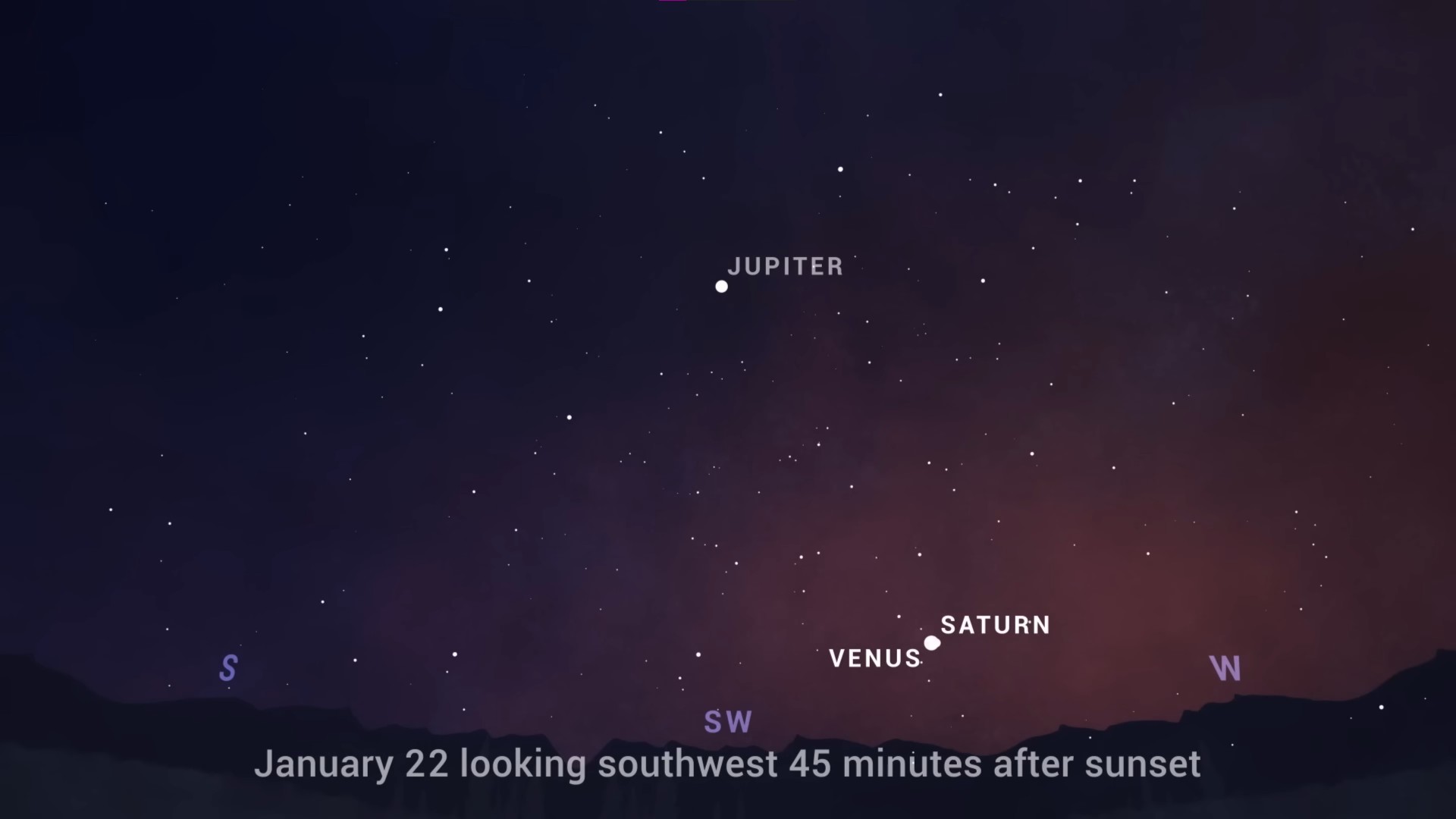Watch Venus and Saturn shine extra close together in a planet conjunction today in this free webcast (Jan. 22)
The conjunction will be the closest observable pairing of naked-eye planets this year.
During the evening of Sunday (Jan. 22) the solar system planets Saturn and Venus will meet up in the night sky making a close approach. Luckily, skywatchers who don't want to brave the bitter cold of January can watch the encounter from the comfort of their homes.
The Virtual Telescope Project will stream the close-approach and the arrangement, known as a "conjunction," between Venus, the second planet from the sun, and Saturn, the solar system's second-largest planet. The livestream will begin while the two planets will be separated by less than half a degree, which is less than the angular size of the full moon, and is equivalent to half the width of a finger at arm's length.
The Virtual Telescope Project's livestream of the conjunction of Venus and Saturn will begin at 1:30 pm EST (1830 GMT) on Sunday (Jan. 22) and will be available to watch online for free courtesy of the project's website or YouTube channel.
Related: What time is the conjunction of Venus and Saturn on Sunday (Jan. 22)?
Both Saturn and Venus are visible to the naked eye in the night sky, but there is a massive difference between the brightness of the two. Venus is the brightest object in the sky after the sun and the moon and during the conjunction will be at magnitude -3.9. Saturn, famous for the rings which encircle it, will be at magnitude 0.7 during the conjunction. (Negative numbers indicate bright objects in the sky.)
That means Saturn will be 100 times fainter than Venus during the conjunction according to Virtual Telescope Project head and astrophysicist Gianluca Masi. Masi will be observing the conjunction between Venus and Saturn from Ceccano, Italy.
During the conjunction, the two planets will be close enough in the night sky to be resolved with a telescope. Skywatchers will also be able to observe the conjunction with binoculars or with the naked eye, though Saturn may be difficult to spot without assistance from an instrument.
Breaking space news, the latest updates on rocket launches, skywatching events and more!
Conditions for viewing the spectacle should be favorable, weather permitting, as the the moon will only be a 2% illuminated crescent the day following January's new moon on Saturday (Jan. 21).

Want to get a closer look at Venus and Saturn? We recommend the Celestron Astro Fi 102 as the top pick in our best beginner's telescope guide.
According to In the Sky, from New York City the conjunction between Venus and Saturn will become visible in the constellation of Capricorn at around 5:18 p.m. EST (2218 GMT) at around 14 degrees over the horizon to the southwest. The planets will set around two hours after the sun at 6:48 p.m. EST (2348 GMT).
The conjunction of these planets marks the beginning of the evening apparition of Venus. According to Space.com's Joe Rao, the evening apparition of Venus will see it literally soar high into the heavens by late spring during which time the already bright planet will more than double its brightness.
As Venus rises above the horizon, during this period Saturn will lower in the night sky each subsequent night, disappearing into the twilight as it does so. This is leading to Saturn's solar conjunction on Feb. 16th, 2023.
If you're hoping to observe the conjunction between Saturn and Venus for yourself, our guides for the best telescopes and best binoculars are a great place to start. If you're looking to take some photos of the conjunction, see our best cameras for astrophotography and best lenses for astrophotography.
Editor's Note: If you snap the conjunction between Saturn and Venus, and would like to share it with Space.com's readers, send your photo(s), comments, and your name and location to spacephotos@space.com. This story was updated on Jan. 22 to include the new start time for this livestream and to include its YouTube video feed.
Follow us @Spacedotcom, or on Facebook and Instagram.

Robert Lea is a science journalist in the U.K. whose articles have been published in Physics World, New Scientist, Astronomy Magazine, All About Space, Newsweek and ZME Science. He also writes about science communication for Elsevier and the European Journal of Physics. Rob holds a bachelor of science degree in physics and astronomy from the U.K.’s Open University. Follow him on Twitter @sciencef1rst.


